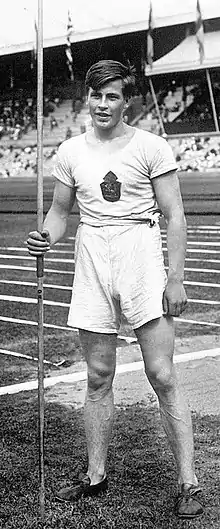| Athletics Javelin throw | |
|---|---|
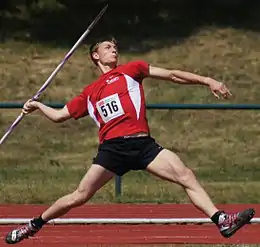 German javelin thrower Thomas Röhler in 2011 | |
| World records | |
| Men | |
| Women | |
| Olympic records | |
| Men | |
| Women | |
| World Championship records | |
| Men | |
| Women | |
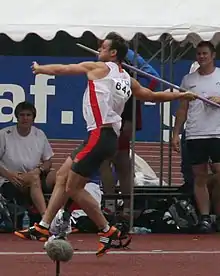
The javelin throw is a track and field event where the javelin, a spear about 2.5 m (8 ft 2 in) in length, is thrown as far as possible. The javelin thrower gains momentum by running within a predetermined area. Javelin throwing is an event of both the men's decathlon and the women's heptathlon.
History

The javelin throw was added to the Ancient Olympic Games as part of the pentathlon in 708 BC. It included two events, one for distance and the other for accuracy in hitting a target. The javelin was thrown with the aid of a thong (ankyle in Greek) that was wound around the middle of the shaft. Athletes held the javelin by the ankyle, and when they released the shaft, the unwinding of the thong gave the javelin a spiral trajectory.
Throwing javelin-like poles into targets was revived in Germany and Sweden in the early 1870s. In Sweden, these poles developed into the modern javelin, and throwing them for distance became a common event there and in Finland in the 1880s. The rules continued to evolve over the next decades; originally, javelins were thrown with no run-up, and holding them by the grip at the center of gravity was not always mandatory. Limited run-ups were introduced in the late 1890s, and soon developed into the modern unlimited run-up.[1]: 435–436
Sweden's Eric Lemming, who threw his first world best (49.32 meters) in 1899 and ruled the event from 1902 to 1912, was the first dominant javelin thrower.[1]: 436, 441 [2]: 478 When the men's javelin was introduced as an Olympic discipline at the 1906 Intercalated Games, Lemming won by almost nine metres and broke his own world record; Sweden swept the first four places, as Finland's best throwers were absent and the event had yet to become popular in any other country.[1]: 437 Though challenged by younger talents, Lemming repeated as Olympic champion in 1908 and 1912; his eventual best mark (62.32 m, thrown after the 1912 Olympics) was the first javelin world record to be officially ratified by the International Association of Athletics Federations.[1]: 436–441 [3]
In the late 19th and early 20th century, most javelin competitions were two-handed; the implement was thrown with the right hand and separately with the left hand, and the best marks for each hand were added together. Competitions for the better hand only were less common, though not unknown.[2] At the Olympics, a both-hands contest was held only once, in 1912; Finland swept the medals, ahead of Lemming.[1]: 441 After that, this version of the javelin rapidly faded into obscurity, together with similar variations of the shot and the discus; Sweden's Yngve Häckner, with his total of 114.28 m from 1917, was the last official both-hands world record holder.[4]
Another early variant was the freestyle javelin, in which holding the javelin by the grip at the center of gravity was not mandatory; such a freestyle competition was held at the 1908 Olympics, but was dropped from the program after that.[2]: 478 Hungary's Mór Kóczán used a freestyle end grip to break the 60-meter barrier in 1911, a year before Lemming and Julius Saaristo first did so with a regular grip.[1]: 440 [5]: 214
The first known women's javelin marks were recorded in Finland in 1909.[6] Originally, women threw the same implement as men; a lighter, shorter javelin for women was introduced in the 1920s. Women's javelin throw was added to the Olympic program in 1932; Mildred "Babe" Didrikson of the United States became the first champion.[2]: 479
For a long time, javelins were made of solid wood, typically birch, with a steel tip. The hollow, highly aerodynamic Held javelin, invented by American thrower Bud Held and developed and manufactured by his brother Dick, was introduced in the 1950s; the first Held javelins were also wooden with steel tips, but later models were made entirely of metal.[2]: 478–479 [6][7] These new javelins flew further, but were also less likely to land neatly point first; as a response to the increasingly frequent flat or ambiguously flat landings, experiments with modified javelins started in the early 1980s. The resulting designs, which made flat landings much less common and reduced the distances thrown, became official for men starting in April 1986 and for women in April 1999, and the world records (then 104.80 m by Uwe Hohn, and 80.00 m by Petra Felke) were reset.[8] The current (as of 2017) men's world record is held by Jan Železný at 98.48 m (1996); Barbora Špotáková holds the women's world record at 72.28 m (2008).
Of the 69 Olympic medals that have been awarded in the men's javelin, 32 have gone to competitors from Norway, Sweden or Finland. Finland is the only nation to have swept the medals at a currently recognized official Olympics, and has done so twice, in 1920 and 1932, in addition to its 1912 sweep in the two-handed javelin; in 1920 Finland swept the first four places, which is no longer possible as only three entrants per country are allowed. Finland has, however, never been nearly as successful in the women's javelin.[2]: 479
The javelin throw has been part of the decathlon since the decathlon was introduced in the early 1910s; the all-around, an earlier ten-event contest of American origin, did not include the javelin throw. The javelin was also part of some (though not all) of the many early forms of women's pentathlon and has always been included in the heptathlon after it replaced the pentathlon in 1981.[9]
Rules and competitions
The size, shape, minimum weight, and center of gravity of the javelin are all defined by World Athletics rules. In international competition, men throw a javelin between 2.6 and 2.7 m (8 ft 6 in and 8 ft 10 in) in length and 800 g (28 oz) in weight, and women throw a javelin between 2.2 and 2.3 m (7 ft 3 in and 7 ft 7 in) in length and 600 g (21 oz) in weight. The javelin has a grip, about 150 mm (5.9 in) wide, made of cord and located at the javelin's center of gravity (0.9 to 1.06 m (2 ft 11 in to 3 ft 6 in)) from the javelin tip for the men's javelin and 0.8 to 0.92 m (2 ft 7 in to 3 ft 0 in) from the javelin tip for the women's javelin.
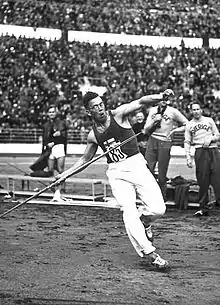
Unlike the other throwing events (shot put, discus, and hammer), the technique used to throw the javelin is dictated by World Athletics rules and "non-orthodox" techniques are not permitted. The javelin must be held at its grip and thrown overhand, over the athlete's shoulder or upper arm. Further, the athlete is prohibited from turning completely around or starting with their back facing the direction of the throw. This prevents athletes from attempting to spin and hurl the javelin sidearm in the style of a discus throw. This rule was put in place when a group of athletes began experimenting with a spin technique referred to as "free style". On 24 October 1956, Pentti Saarikoski threw 99.52 m (326 ft 6 in)[10] using the technique holding the end of the javelin. Officials were so afraid of the out of control nature of the technique that the practice was banned through these rule specifications.
Instead of being confined to a circle, javelin throwers have a runway 4 m (13 ft) wide and at least 30 m (98 ft) in length, ending in an 8 m (26 ft) radius throwing arc from which their throw is measured; athletes typically use this distance to gain momentum in a "run-up" to their throw. Like the other throwing events, the competitor may not leave the throwing area (the runway) until after the implement lands. The need to come to a stop behind the throwing arc limits both how close the athlete can come to the line before the release as well as the maximum speed achieved at the time of release.
The javelin is thrown towards a 28.96º circular sector that is centered on the center point of the throwing arc. The angle of the throwing sector (28.96º) provides sector boundaries that are easy to construct and lay out on a field.[11] A throw is only legal if the tip of the javelin lands within this sector and first strikes the ground with its tip before any other part.[12] The distance of the throw is measured from the throwing arc to the point where the tip of the javelin landed, rounded down to the nearest centimeter.
Competition rules are similar to other throwing events: a round consists of one attempt by each competitor in turn, and competitions typically consist of three to six rounds. The competitor with the longest single legal throw (over all rounds) is the winner; in case of a tie, the competitors' second-longest throws are also considered. Competitions involving large numbers of athletes sometimes use a cut whereby all competitors compete in the first three rounds but only those who are currently among the top eight or have achieved some minimum distances are permitted to attempt to improve on their distance in additional rounds (typically three).
Javelin redesigns

On 1 April 1986, the men's javelin (800 grams (1.76 lb)) was redesigned by the governing body (the IAAF Technical Committee). They decided to change the rules for javelin design because of the increasingly frequent flat landings and the resulting discussions and protests when these attempts were declared valid or invalid by competition judges. The world record had also crept up to a potentially dangerous level, 104.80 m (343.8 ft) by Uwe Hohn. With throws exceeding 100 meters, it was becoming difficult to safely stage the competition within the confines of a stadium infield. The javelin was redesigned so that the centre of gravity was moved 4 cm (1.6 in) forward. In addition, the surface area in front of centre of gravity was reduced, while the surface area behind the centre of gravity was increased. This had an effect similar to that produced by the feathers on an arrow. The javelin turns into the relative wind. This relative wind appears to originate from the ground as the javelin descends, thus the javelin turns to face the ground. As the javelin turns into the wind less lift is generated, reducing the flight distance by around 10% but also causing the javelin to stick in the ground more consistently. In 1999, the women's javelin (600 grams (1.32 lb)) was similarly redesigned.[13]
Modifications that manufacturers made to recover some of the lost distance, by increasing tail drag (using holes, rough paint or dimples), were forbidden at the end of 1991 and performances made using implements with such modifications removed from the record books. Seppo Räty had achieved a world record of 96.96 m (318.1 ft) in 1991 with such a design, but this record was nullified.
Weight rules by age group
The weight of the javelin in the Under-20 category is the same as the senior level.[14]
| Men | Women | ||
| Age group | Weight | Weight | |
| U14 | 400 g (14 oz) | ||
| U16 | 600 g (1 lb 5 oz) | 500 g (1 lb 2 oz) | |
| U18 | 700 g (1 lb 9 oz) | ||
| Junior (U20) | 800 g (1 lb 12 oz) | 600 g (1 lb 5 oz) | |
| Senior | |||
| 35–49 | |||
| 50–74 | 500 g (1 lb 2 oz) | ||
| 50–59 | 700 g (1 lb 9 oz) | ||
| 60–69 | 600 g (1 lb 5 oz) | ||
| 70–79 | 500 g (1 lb 2 oz) | ||
| 75+ | 400 g (14 oz) | ||
| 80+ | 400 g (14 oz) | ||
Technique and training
Unlike other throwing events, javelin allows the competitor to build speed over a considerable distance. In addition, the core and upper body strength is necessary to deliver the implement, javelin throwers benefit from the agility and athleticism typically associated with running and jumping events. Thus, the athletes share more physical characteristics with sprinters than with others, although they still need the skill of heavier throwing athletes.
Traditional free-weight training is often used by javelin throwers. Metal-rod exercises and resistance band exercises can be used to train a similar action to the javelin throw to increase power and intensity. Without proper strength and flexibility, throwers can become extremely injury prone, especially in the shoulder and elbow. Core stability can help in the transference of physical power and force from the ground through the body to the javelin. Stretching and sprint training are used to enhance the speed of the athlete at the point of release, and subsequently, the speed of the javelin. At release, a javelin can reach speeds approaching 113 km/h (70 mph).
The javelin throw consists of three separate phases: the run-up, the transition, and the delivery. During each phase, the position of the javelin changes while the thrower changes his or her muscle recruitment. In the run-up phase as Luann Voza states, "your arm is bent and kept close to your head, keeping the javelin in alignment with little to no arm movement".[15] This allows the thrower's bicep to contract, flexing the elbow. In order for the javelin to stay up high, the thrower's deltoid flexes. In the transition phase, the thrower's "back muscles contract" as "the javelin is brought back in alignment with the shoulder with the thrower's palm up".[15] This, according to Voza, "stretches your pectoral, or chest, muscles. From there, a stretch reflex, an involuntary contraction of your chest, helps bring your throwing arm forward with increased force".[15] During the final phase, the rotation of the shoulders initiates the release, which then "transfers movement through the triceps muscles, wrists and fingers to extend the throwing arm forward to release the javelin".[15]
Culture

In 1994, Michael Torke composed Javelin, commissioned by the Atlanta Committee for the Olympic Games in celebration of the Atlanta Symphony Orchestra's 50th anniversary season, in conjunction with the 1996 Summer Olympics.
Javelin throwers have been selected as a main motif in numerous collectors' coins. One of the recent samples is the €5 Finnish 10th IAAF World Championships in Athletics commemorative coin, minted in 2005 to commemorate the 2005 World Championships in Athletics. On the obverse of the coin, a javelin thrower is depicted. On the reverse, legs of hurdle runners with the Helsinki Olympic Stadium tower in the background can be seen.
All-time top 25 (current models)
| Tables show data for two definitions of "Top 25" - the top 25 distances and the top 25 athletes: |
| - denotes top performance for a repeat athlete in the top 25 distances |
| - denotes lesser performances, still in the top 25 distances, by a repeat athlete |
| - denotes top performance (only) for other top 25 athletes who fall outside the top 25 distances |
Men
| Ath.# | Perf.# | Mark | Athlete | Nation | Date | Place | Ref. |
|---|---|---|---|---|---|---|---|
| 1 | 1 | 98.48 m (323 ft 1 in) | Jan Železný | 25 May 1996 | Jena | ||
| 2 | 2 | 97.76 m (320 ft 8+3⁄4 in) | Johannes Vetter | 6 September 2020 | Chorzów | [18] | |
| 3 | 96.29 m (315 ft 10+3⁄4 in) | Vetter #2 | 29 May 2021 | Chorzów | |||
| 4 | 95.66 m (313 ft 10 in) | Železný #2 | 29 August 1993 | Sheffield | |||
| 5 | 95.54 m (313 ft 5+1⁄4 in) A | Železný #3 | 6 April 1993 | Pietersburg | |||
| 6 | 94.64 m (310 ft 5+3⁄4 in) | Železný #4 | 31 May 1996 | Ostrava | |||
| 7 | 94.44 m (309 ft 10 in) | Vetter #3 | 11 July 2017 | Luzern | |||
| 8 | 94.20 m (309 ft 1⁄2 in) | Vetter #4 | 19 May 2021 | Ostrava | |||
| 9 | 94.02 m (308 ft 5+1⁄2 in) | Železný #5 | 26 March 1997 | Stellenbosch | |||
| 3 | 10 | 93.90 m (308 ft 3⁄4 in) | Thomas Röhler | 5 May 2017 | Doha | [19] | |
| 11 | 93.88 m (308 ft 0 in) | Vetter #5 | 18 August 2017 | Thum | |||
| 12 | 93.59 m (307 ft 1⁄2 in) | Vetter #6 | 26 June 2021 | Kuortane | |||
| 13 | 93.20 m (305 ft 9+1⁄4 in) | Vetter #7 | 21 May 2021 | Dessau | |||
| 4 | 14 | 93.09 m (305 ft 4+3⁄4 in) | Aki Parviainen | 26 June 1999 | Kuortane | ||
| 5 | 15 | 93.07 m (305 ft 4 in) | Anderson Peters | 13 May 2022 | Doha | [20] | |
| 16 | 92.80 m (304 ft 5+1⁄2 in) | Železný #6 | 12 August 2001 | Edmonton | |||
| 6 | 17 | 92.72 m (304 ft 2+1⁄4 in) | Julius Yego | 26 August 2015 | Beijing | [21] | |
| 18 | 92.70 m (304 ft 1+1⁄2 in) | Vetter #8 | 11 March 2018 | Leiria | |||
| 7 | 19 | 92.61 m (303 ft 10 in) | Sergey Makarov | 30 June 2002 | Sheffield | ||
| 8 | 20 | 92.60 m (303 ft 9+1⁄2 in) | Raymond Hecht | 14 August 1996 | Zürich | ||
| 21 | 92.42 m (303 ft 2+1⁄2 in) | Železný #7 | 28 May 1997 | Ostrava | |||
| 22 | 92.41 m (303 ft 2 in) | Parviainen #2 | 24 June 2001 | Vaasa | |||
| 23 | 92.28 m (302 ft 9 in) | Železný #8 | 9 September 1995 | Monaco | |||
| Hecht #2 | 14 August 1996 | Zürich | |||||
| 25 | 92.14 m (302 ft 3+1⁄2 in) | Vetter #9 | 29 June 2021 | Luzern | |||
| 9 | 92.06 m (302 ft 1⁄4 in) | Andreas Hofmann | 2 June 2018 | Offenburg | [22] | ||
| 10 | 91.69 m (300 ft 9+3⁄4 in) | Konstadinós Gatsioúdis | 24 June 2000 | Kuortane | |||
| 11 | 91.59 m (300 ft 5+3⁄4 in) | Andreas Thorkildsen | 2 June 2006 | Oslo | |||
| 12 | 91.53 m (300 ft 3+1⁄2 in) | Tero Pitkämäki | 26 June 2005 | Kuortane | |||
| 13 | 91.46 m (300 ft 3⁄4 in) | Steve Backley | 25 January 1992 | Auckland | [23] | ||
| 14 | 91.36 m (299 ft 8+3⁄4 in) | Cheng Chao-tsun | 26 August 2017 | Taipei | [24] | ||
| 15 | 91.29 m (299 ft 6 in) | Breaux Greer | 21 June 2007 | Indianapolis | |||
| 16 | 90.88 m (298 ft 1+3⁄4 in) | Jakub Vadlejch | 13 May 2022 | Doha | [20] | ||
| 17 | 90.82 m (297 ft 11+1⁄2 in) | Kimmo Kinnunen | 26 August 1991 | Tokyo | |||
| 18 | 90.73 m (297 ft 8 in) | Vadims Vasiļevskis | 22 July 2007 | Tallinn | |||
| 19 | 90.61 m (297 ft 3+1⁄4 in) | Magnus Kirt | 22 June 2019 | Kuortane | [25] | ||
| 20 | 90.60 m (297 ft 2+3⁄4 in) | Seppo Räty | 20 July 1992 | Nurmijärvi | |||
| 21 | 90.44 m (296 ft 8+1⁄2 in) | Boris Henry | 9 July 1997 | Linz | |||
| 22 | 90.18 m (295 ft 10+1⁄4 in) | Arshad Nadeem | 7 August 2022 | Birmingham | [26] | ||
| 23 | 90.16 m (295 ft 9+1⁄2 in) | Keshorn Walcott | 9 July 2015 | Lausanne | |||
| 24 | 89.94 m (295 ft 3⁄4 in) | Neeraj Chopra | 30 June 2022 | Stockholm | [27] | ||
| 25 | 89.83 m (294 ft 8+1⁄2 in) | Oliver Helander | 14 June 2022 | Turku | [28] |
Women
- Correct as of September 2023.[29]
| Ath.# | Perf.# | Mark | Athlete | Nation | Date | Place | Ref. |
|---|---|---|---|---|---|---|---|
| 1 | 1 | 72.28 m (237 ft 1+1⁄2 in) | Barbora Špotáková | 13 September 2008 | Stuttgart | ||
| 2 | 2 | 71.70 m (235 ft 2+3⁄4 in) | Osleidys Menéndez | 14 August 2005 | Helsinki | ||
| 3 | 71.58 m (234 ft 10 in) | Špotáková #2 | 2 September 2011 | Daegu | |||
| 4 | 71.54 m (234 ft 8+1⁄2 in) | Menéndez #2 | 1 July 2001 | Rethymno | |||
| 5 | 71.53 m (234 ft 8 in) | Menéndez #3 | 27 August 2004 | Athens | |||
| 6 | 71.42 m (234 ft 3+3⁄4 in) | Špotáková #3 | 21 August 2008 | Beijing | |||
| 3 | 7 | 71.40 m (234 ft 3 in) | Maria Andrejczyk | 9 May 2021 | Split | [30] | |
| 4 | 8 | 70.53 m (231 ft 4+3⁄4 in) | Mariya Abakumova | 1 September 2013 | Berlin | ||
| 5 | 9 | 70.20 m (230 ft 3+3⁄4 in) | Christina Obergföll | 23 June 2007 | Munich | ||
| 10 | 70.03 m (229 ft 9 in) | Obergföll #2 | 14 August 2005 | Helsinki | |||
| 11 | 69.82 m (229 ft 3⁄4 in) | Menéndez #4 | 29 August 2001 | Beijing | |||
| 12 | 69.81 m (229 ft 1⁄4 in) | Obergföll #3 | 31 August 2008 | Elstal | |||
| 13 | 69.75 m (228 ft 10 in) | Abakumova #2 | 25 August 2013 | Elstal | |||
| 14 | 69.57 m (228 ft 2+3⁄4 in) | Obergföll #4 | 8 September 2011 | Zürich | |||
| 15 | 69.55 m (228 ft 2 in) | Špotáková #4 | 9 August 2012 | London | |||
| 16 | 69.53 m (228 ft 1+1⁄4 in) | Menéndez #5 | 6 August 2001 | Edmonton | |||
| 6 | 17 | 69.48 m (227 ft 11+1⁄4 in) | Trine Hattestad | 28 July 2000 | Oslo | ||
| 18 | 69.45 m (227 ft 10+1⁄4 in) | Špotáková #5 | 22 July 2011 | Monaco | |||
| 7 | 19 | 69.35 m (227 ft 6+1⁄4 in) | Sunette Viljoen | 9 June 2012 | New York City | ||
| 20 | 69.34 m (227 ft 5+3⁄4 in) | Abakumova #3 | 16 March 2013 | Castellón | |||
| 8 | 21 | 69.19 m (227 ft 0 in) | Christin Hussong | 30 May 2021 | Chorzów | [31] | |
| 22 | 69.15 m (226 ft 10+1⁄4 in) | Špotáková #6 | 31 May 2008 | Zaragoza | |||
| 23 | 69.09 m (226 ft 8 in) | Abakumova #4 | 16 August 2013 | Moscow | |||
| 24 | 69.05 m (226 ft 6+1⁄2 in) | Obergföll #5 | 18 August 2013 | Moscow | |||
| 25 | 68.94 m (226 ft 2 in) | Abakumova #5 | 29 August 2013 | Zürich | |||
| 9 | 68.92 m (226 ft 1+1⁄4 in) | Kathryn Mitchell | 11 April 2018 | Gold Coast | [32] | ||
| 10 | 68.43 m (224 ft 6 in) | Sara Kolak | 6 July 2017 | Lausanne | [33] | ||
| 11 | 68.34 m (224 ft 2+1⁄2 in) | Steffi Nerius | 31 August 2008 | Elstal | |||
| 12 | 68.11 m (223 ft 5+1⁄4 in) | Kara Winger | 2 September 2022 | Brussels | [34] | ||
| 13 | 67.98 m (223 ft 1⁄4 in) | Lü Huihui | 2 August 2019 | Shenyang | [35] | ||
| 14 | 67.70 m (222 ft 1+1⁄4 in) | Kelsey-Lee Barber | 9 July 2019 | Lucerne | [36] | ||
| 15 | 67.69 m (222 ft 3⁄4 in) | Katharina Molitor | 30 August 2015 | Beijing | [37] | ||
| 16 | 67.67 m (222 ft 0 in) | Sonia Bisset | 6 July 2005 | Salamanca | |||
| 17 | 67.51 m (221 ft 5+3⁄4 in) | Mirela Manjani | 30 September 2000 | Sydney | |||
| 18 | 67.47 m (221 ft 4+1⁄4 in) | Tatsiana Khaladovich | 7 June 2018 | Oslo | [38] | ||
| 19 | 67.40 m (221 ft 1+1⁄2 in) | Nikola Ogrodníková | 26 May 2019 | Offenburg | [39] | ||
| Maggie Malone | 17 July 2021 | East Stroudsburg | |||||
| 21 | 67.38 m (221 ft 3⁄4 in) | Haruka Kitaguchi | 8 September 2023 | Brussels | [40] | ||
| 22 | 67.32 m (220 ft 10+1⁄4 in) | Linda Stahl | 14 June 2014 | New York City | |||
| 23 | 67.30 m (220 ft 9+1⁄2 in) | Vera Rebrik | 19 February 2016 | Sochi | |||
| 24 | 67.29 m (220 ft 9 in) | Hanna Hatsko-Fedusova | 26 July 2014 | Kirovohrad | |||
| Liu Shiying | 15 September 2020 | Shaoxing | [41] |
Annulled marks
- In 2011, Mariya Abakumova threw 71.99 metres. This performance was annulled due to doping offences.
All-time top 5 (dimpled models 1990–1991)
Marks set using dimpled rough-tailed javelins manufactured by several companies were nullified effective 20 September 1991.[5]: 208–209
| Rank | Mark | Athlete | Date | Place | Ref |
|---|---|---|---|---|---|
| 1 | 96.96 | 2 June 1991 | Punkalaidun | [42] | |
| 2 | 91.36 | 15 September 1991 | Sheffield | ||
| 3 | 90.84 | 8 September 1991 | Gengenbach | ||
| 4 | 90.82 | 26 August 1991 | Tokyo | ||
| 5 | 90.72 | 10 July 1991 | Lausanne |
All-time top 15 (old models)
Men
| Rank | Mark | Athlete | Date | Place | Ref |
|---|---|---|---|---|---|
| 1 | 104.80 | 21 July 1984 | Berlin | ||
| 2 | 99.72 | 15 May 1983 | Westwood | ||
| 3 | 96.72 | 23 April 1980 | Tata | ||
| 9 June 1983 | Berlin | ||||
| 5 | 95.80 | 29 August 1982 | Stuttgart | ||
| 6 | 95.10 | 5 August 1985 | Eugene | ||
| 7 | 94.58 | 26 July 1976 | Montreal | ||
| 8 | 94.22 | 3 August 1978 | Oslo | ||
| 9 | 94.20 | 5 June 1983 | Birmingham | ||
| 10 | 94.08 | 5 May 1973 | Leverkusen | ||
| 11 | 94.06 | 26 July 1985 | Eugene | ||
| 12 | 93.90 | 6 June 1973 | Helsinki | ||
| 13 | 93.84 | 27 January 1979 | Auckland | ||
| 14 | 93.80 | 6 July 1972 | Stockholm | ||
| 15 | 93.70 | 17 July 1985 | Kyiv |
Women

| Rank | Mark | Athlete | Date | Place | Ref |
|---|---|---|---|---|---|
| 1 | 80.00 | 8 September 1988 | Potsdam | ||
| 2 | 77.44 | 28 August 1986 | Stuttgart | ||
| 3 | 74.76 | 13 June 1983 | Tampere | ||
| 4 | 74.20 | 26 September 1982 | Hania | ||
| 5 | 73.58 | 26 June 1983 | Edinburgh | ||
| 6 | 72.70 | 20 May 1984 | Hania | ||
| 7 | 72.16 | 5 May 1984 | Celje | ||
| 8 | 72.12 | 10 July 1993 | Oslo | ||
| 9 | 71.88 | 15 August 1981 | Zagreb | ||
| 10 | 71.82 | 30 August 1985 | Leverkusen | ||
| 11 | 71.40 | 5 June 1994 | Sevilla | ||
| 12 | 71.00 | 25 June 1988 | Rostock | ||
| 13 | 70.76 | 22 June 1989 | Rostock | ||
| 14 | 70.42 | 6 August 1990 | Tianjin | ||
| 15 | 70.20 | 9 May 1991 | Halle |
Olympic medalists
Men
Women
World Championships medalists
Men
Women
Season's bests
Men
A new model was introduced in 1986, and all records started fresh. |
Women
A new model was introduced in 1999 and all records started fresh. 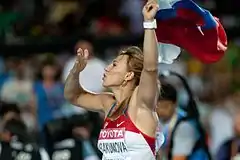 Maria Abakumova at the 2011 World Athletics Championships
|
See also
References
- 1 2 3 4 5 6 Jukola, Martti (1935). Huippu-urheilun historia (in Finnish). Werner Söderström Osakeyhtiö.
- 1 2 3 4 5 6 Kanerva, Juha; Tikander, Vesa. Urheilulajien synty (in Finnish). Teos. ISBN 9789518513455.
- ↑ "12th IAAF World Championships In Athletics: IAAF Statistics Handbook. Berlin 2009" (PDF). Monte Carlo: IAAF Media & Public Relations Department. 2009. pp. Pages 546, 559. Archived from the original (PDF) on 29 June 2011. Retrieved 5 August 2009.
- ↑ Vélez Blasco, Miguel. "Part III: Llançaments – Tema 12 Javelina" (PDF) (in Catalan). Institut Nacional d'Educació Física de Catalunya / Federació Catalana d'Atletisme. Archived from the original (PDF) on 2 April 2015.
- 1 2 Hymans, Richard; Matrahazi, Imre. "IAAF World Records Progression" (PDF) (2015 ed.). International Association of Athletics Federations. Retrieved 20 October 2015.
- 1 2 "Javelin Throw – Introduction". IAAF. Archived from the original on 6 June 2012.
- ↑ "Track: A Salute to the Javelin And Its Practitioners—One of Whom, Bud Held, Is Showing Those Finns A Thing Or Two". Sports Illustrated. 6 June 1955. Retrieved 8 March 2017.
- ↑ Bremicher, Erick. "Why did the senior javelin specification have to be changed?". Archived from the original on 23 September 2018. Retrieved 22 May 2015.
- ↑ IAAF Scoring Tables for Combined Events, pp. 7–10.
- ↑ Pentti Saarikosk
- ↑ "Laying Out Sector Angles for the Track and Field Throwing Events" (PDF). USA Track & Field Pacific Northwest. Retrieved 19 March 2022.
- ↑ "Javelin Throw". worldathletics.org. Retrieved 22 January 2021.
- ↑ "Physics: Javelin Designs, what's the significance? – World of Javelin". worldofjavelin.com. Archived from the original on 2 April 2015. Retrieved 27 March 2012.
- ↑ "Throwing Weight Rules per Age Group". athleticsdirect.co.uk. 7 July 2016. Retrieved 10 July 2018.
- 1 2 3 4 Luann Voza (21 February 2019). "Describe the Sequence of Arm Muscle Movements in Throwing a Javelin". SportsRec. Retrieved 24 February 2019.
- ↑ "Javelin Throw – men – senior – outdoor". worldathletics.org. Retrieved 8 June 2021.
- ↑ "Men's javelin". alltime-athletics.com. Retrieved 13 September 2022.
- ↑ Bob Ramsak (6 September 2020). "Vetter threatens javelin world record with 97.76m throw in Silesia". World Athletics. Retrieved 15 September 2020.
- ↑ "Javelin Throw Results" (PDF). sportresult.com. 5 May 2017. Archived from the original (PDF) on 27 August 2019. Retrieved 5 May 2017.
- 1 2 Jon Mulkeen (14 May 2022). "Peters prevails in javelin thriller at windy Diamond League debut in Doha". World Athletics. Retrieved 26 May 2022.
- ↑ "Javelin Throw Results". IAAF. 26 August 2015. Archived from the original on 13 August 2017. Retrieved 26 August 2015.
- ↑ "Hofmann improves to 92.06m in Offenburg". European Athletics. 3 June 2018. Retrieved 4 June 2018.
- ↑ British Athletics. "British Athletics Official WebsiteSteve Backley". britishathletics.org.uk. Archived from the original on 23 September 2015.
- ↑ "UNIVERSIADE: Taiwan's Cheng wins record-breaking gold in javelin". focustaiwan.tw. 26 August 2017. Archived from the original on 26 August 2017. Retrieved 26 August 2017.
- ↑ "Kirt extends world lead in the javelin to 90.61m in Kuortane". European Athletics. 22 June 2019. Archived from the original on 23 June 2019. Retrieved 26 June 2019.
- ↑ "Athletics Commonwealth Games 2022, Highlights: Eldhose Paul, Aboobacker on podium in triple jump; Pakistan's Arshad Nadeem wins javelin gold". 7 August 2022.
- ↑ Simon Turnbull (30 June 2022). "Duplantis scales 6.16m in Stockholm for highest ever outdoor vault". World Athletics. Retrieved 16 July 2022.
- ↑ "Javelin Throw Results". World Athletics. 14 June 2022. Retrieved 15 June 2022.
- ↑ "All-time women's best Javelin throw". alltime-athletics.com. Retrieved 9 January 2017.
- ↑ Jess Whittington (9 May 2021). "Rojas opens with 15.14m, Andrejczyk throws 71.40m". World Athletics. Retrieved 20 May 2021.
- ↑ Jess Whittington (29 May 2021). "Vetter throws 96.29m in Silesia for third best javelin mark in history". World Athletics. Retrieved 22 June 2021.
- ↑ "Javelin Throw Results" (PDF). gc2018.com. 11 April 2018. Archived from the original (PDF) on 16 April 2018. Retrieved 15 April 2018.
- ↑ "Javelin Throw Results" (PDF). sportresult.com. 6 July 2017. Retrieved 9 July 2017.
- ↑ Jon Mulkeen (2 September 2022). "Krop, Mahuchikh and Winger bounce back in Brussels with world-leading marks". World Athletics. Retrieved 14 September 2022.
- ↑ Jon Mulkeen (4 August 2019). "National championships round-up: Mihambo leaps world-leading 7.16m in Berlin". IAAF. Retrieved 12 August 2019.
- ↑ Diego Sampaolo (9 July 2019). "Barber and Röhler in the spotlight in Lucerne". IAAF. Retrieved 26 July 2019.
- ↑ "Women's Javelin Throw Results". IAAF. 30 August 2015. Archived from the original on 24 September 2015. Retrieved 30 August 2015.
- ↑ "Javelin Throw Results" (PDF). sportresult.com. 7 June 2018. Retrieved 10 June 2018.
- ↑ "Javelin Throw Results". laportal.net. 26 May 2019. Retrieved 26 July 2019.
- ↑ "Javelin Throw Result" (PDF). sportresult.com. 8 September 2023. Retrieved 8 September 2023.
- ↑ Jon Mulkeen (18 September 2020). "Wang and Liu impress at Chinese Championships". World Athletics. Retrieved 30 September 2020.
- ↑ Larsson, Peter. "Track & Field all-time performances: Men's non-legal javelin". Retrieved 2 May 2018.
- ↑ Mariya Abakumova, from Russia, was disqualified in 2016, after retesting. Sayers was later confirmed as the bronze medalist.
- ↑ Original bronze medalist Russian Mariya Abakumova was later disqualified for failing retests of samples
- ↑ Original gold medalist Russian Mariya Abakumova was later disqualified for failing retests of samples
External links
- IAAF list of javelin-throw records in XML
- (IAAF Statement) Archived 23 September 2018 at the Wayback Machine – statement of reasons to modify the javelin design
- Masters World Rankings Archived 5 February 2016 at the Wayback Machine
- IAAF competition rules
